Synaptics Unveils Clear ID In-Display Fingerprint Sensor for 18:9, 20:9 Smartphones
by Anton Shilov on December 14, 2017 1:00 PM EST- Posted in
- Smartphones
- Android
- Synaptics
- AMOLED
- Security
- Biometrics
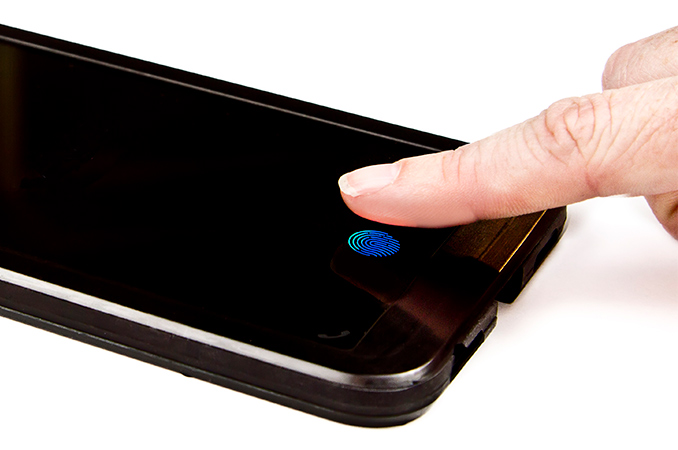
Synaptics this week introduced its first Clear ID FS9500 in-display optical sensor that can be installed under the surface of an OLED screen. The fingerprint reader works faster than facial recognition and can be used in any environments, including dark rooms and sunny beaches, Synaptics says. The first smartphones featuring the technology are due in Q1 2018.
Biometric authentication has become a mandated feature of every smartphone in the recent years, but integrating fingerprint sensor has become a challenge as screen-to-body ratio is growing and many front panels have no space for the reader. Some smartphone makers install fingerprint sensor on the back panels of their devices, other, like Apple, introduce facial recognition technologies that require IR and RGB sensors accompanied by appropriate processing resources. Synaptics argues that fingerprint sensors on the back are uncomfortable to use, whereas facial recognition technologies are relatively slow and can be fooled. By contrast, Synaptics’ latest Clear ID FS9500 sensor is hidden under the screen on the front and it works as fast as users come to expect from similar devices in the recent years.
The Synaptics Clear ID FS9500 fingerprint sensor is a tiny CMOS device that sits below the AMOLED display assemly and captures the reflected fingerprint between and through the OLED pixels. Synaptics said that the captured fingerprint has a very high resolution, but naturally does not quantify this claim. To make a fingerprint reflect, a part of the screen has to be lit-up, so while the device itself only uses 80 mA, the screen consumes some additional power too (Synaptics does not disclose the lowest brightness level of the display required for scanning as it depends on many factors). Meanwhile, Synaptics uses accelerometers and other sensors inside the phone to activate the sensor and turn on an appropriate area on the screen. The activation happens instantly, then it takes 0.7 seconds to scan the fingerprint, match it and grant or deny access. By contrast, Synaptics says, it takes modern smartphones about 1.4 seconds to scan a face.
The SF9500 does not support Match-In-Sensor technology, so the matching is performed by host using Synaptics’ Quantum Matcher software. It is noteworthy that the software Synaptics supplies with its sensors is quite complex. Apart from matching, the software is responsible for activating the reader and the screen whenever the phone is touched and for other things (like taking into account outside conditions that may affect minutiae). The new fingerprint sensor from Synaptics connects to host using the SPI bus. Depending on application and requirements, device manufacturer may choose to use an AES-encrypted SecureLink interface (e.g., if the SF9500 is installed into a bezel-less tablet, or a laptop display) if required.
The Clear ID FS9500 is “smart” enough to detect fingerprints in sunlight and bright conditions, take into account wet and/or cold fingers, detect spoofed fingerprints and so on. It remains to be seen how the sensor behaves when individual light-emitting pixels burn-in over time, but since Synaptics has a robust program stack supplied with its sensors, it can tweak them using software to compensate for screen degradation.
According to Synaptics, the Clear ID SF9500 sensor itself is only 0.69 mm thick and its integration does not make smartphones significantly thicker. The sensor integration process has to be performed by the screen manufacturer at a fab where display assemblies are made and Synaptics is working with appropriate makers. The process is not very complex, so it does not make final devices considerably more expensive, says the developer.
Synaptics initiated mass production of its Clear ID FS9500 sensors this month and will start their commercial shipments in the coming weeks. The company says that the first smartphone that uses the in-display fingerprint reader will be available in early 2018. Synaptics naturally does not disclose the manufacturer of the device, but only says that it is one of the Top 5 smartphone suppliers. Meanwhile, since the FS9500 sensor only works with OLED screens, this big producer of the smartphones has to have access to the AMOLED technology. Synaptics plans to showcase the handset at CES, but it is unclear whether the device will have been announced by that time, or Synaptics will show it camouflaged. Anyway, the first smartphone featuring the FS9500 is incoming and it will be available soon.
Related Reading:
Source: Synaptics


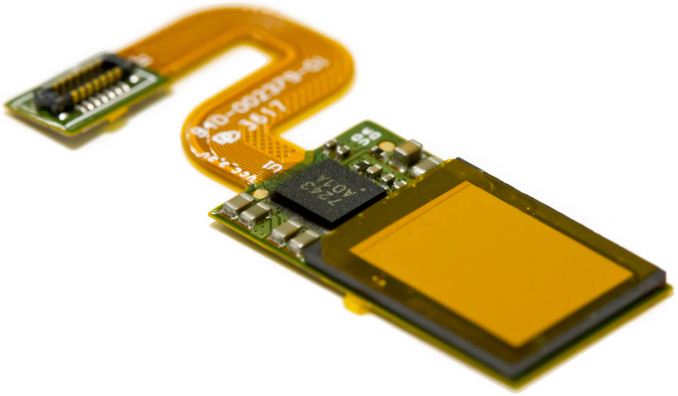
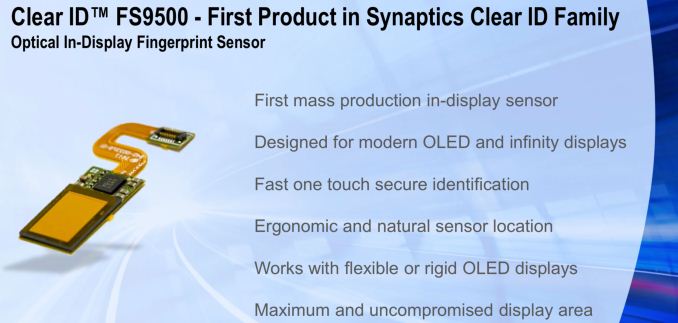
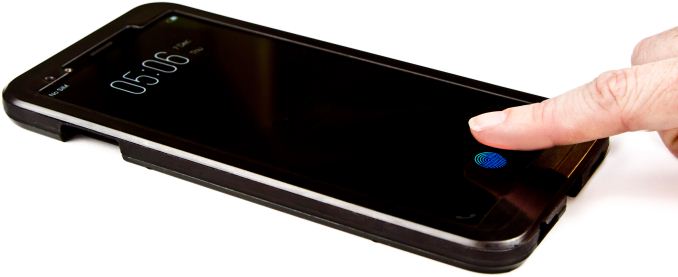
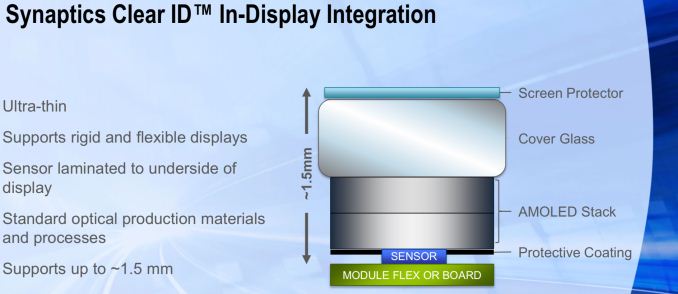








39 Comments
View All Comments
Raniz - Friday, December 15, 2017 - link
Sensor on the back is easier when you've got the phone in your hand, on the front is (a lot) easier when it's not.I don't really see why we can't have both. Put a sensor behind the display and one on the back and you could use whichever is most convenient at the moment.
lazarpandar - Thursday, December 14, 2017 - link
This is actually quite a surprise.lilmoe - Thursday, December 14, 2017 - link
Great. Facial recognition, iris scanning and rear placed fingerprint readers simply suck. I simply don't care for those.Too bad this won't make it to the S9. Not that I'm upset, my S7e is still going strong. But 7nm, in-display fingerprint sensor, the rumored battery tech and hopefully a new design with a more subdued curve should make the GS10 a much worthy upgrade.
Yea, I'll wait.
abufrejoval - Thursday, December 14, 2017 - link
That’s cool technology!Personally, I’m not sure I’d pay extra for it, but it widens the choices.
I wouldn’t pay extra for 18:9, it gives me nothing I value. I would pay extra for 16:10, which I enjoyed ever since my first Galaxy note. Perhaps I’d pay even extra for 2:3. Got fingers that a long enough and I read a lot more than I watch videos on my ultramobile PC.
Security is broken on these devices anyway, so I don’t keep anything on it, that my economic or physical well-being depends on: If someone gets a copy of my 80GB classic CD collection, offline navigation maps or my even my private e-mail, that’s survivable.
So after some years of messing with pattern unlock, I decided to simply leave the phone open: Too complex a pattern, I’d waste concentration unlocking the phone, too simple it became ineffective, because anyone could observe. The phone doesn’t leave my immediate surroundings, so physical security is my biggest “protection”.
To me the built-in front-facing finger print sensor in my current Oneplus 5 initially was simply a free addition to the home-button. It would reduce the damage if a thief were to grab the phone from my hands, so that’s cool.
I like the fact that it is physical, that is locatable by touch without looking and that it works with several fingers/thumbs, so I can unlock it from many positions and without exclusive use of one hand. I like it much more front facing than with a back-side sensor, especially when mounted in the car, where picking it up becomes a punishable offense, whilst touching it mounted is (so far) no different from using a car radio.
For me the key to accepting finger print unlock was that I didn’t have to do anything different: I touched the home button on my other phones to activate them and I did that independently of whether they were lying on the table, mounted in the car or if I actually picked it up to hold in my hand. The only difference is that I tend to use one of my thumbs when I pick it up and a finger when it’s lying or mounted. I only ever use two hands when I have to type something.
I haven’t ever tried face unlock, but it only ever makes sense when you keep your phone constantly in your hand. As a computer professional my primary is still a physical keyboard and a much bigger display (I'd so love it for my mobile to run my screens and keyboards, but, alas, everybody seems to conspire to have me buy another Snapdragon 835 for the desktop, even if mine has 8GB of RAM and 128GB of SSD), so it spends much more time lying on the table or mounted in the car: I wouldn’t know how face-unlock would work there, and I’d hate to meet someone on the road, who tries to face-unlock his phone: It’s bad enough as it is. And I don’t think it gets better, if they have to use the backface fingerprint sensor or enter a complex PIN code in “hands-free” mode. The finger print augmented home button on the front works the same in all scenarios and that I consider a mandatory feature. I had Le Max 2 with a back-side finger print sensor before, but having to differentiate between hand-held and hands-free was so much of a bother I simply kept it unlocked, too.
You can’t get changeable batteries any more, nor a plastic chassis for a premium phone (who cares what’s underneath the silicon sleeve?). So perhaps the next thing to go away forever is the physical home button, because smombies rule the world of phone design.
This hidden home button will allow me to ignore the questionable benefits of fashion and design improvements so I’m glad it’s there.
In short: I don't mind when phone get thinner, have bigger displays or become more "beautiful". But when any of these "improvements" compromise functionality, safety, ergonomics or plain usefulness, it's a no-go.
For me it's tool primarily, not a fashion accessory. Yes, I am late middle age and male and I guess that affects my bias.
serendip - Friday, December 15, 2017 - link
I agree about front facing sensors, they're much easier to use when the phone is on a table or in a car mount, which is probably 90% of the time. A rear sensor works better when you're on the move.I use the rear sensor on my phone more as a password shortcut. It also unlocks my Keepass keyring for basic website logins but private stuff like email and banking logins are on separate keyrings that require typing in long passwords. Maybe someone should make a password app that uses multiple fingers in sequence e.g. index finger, middle finger, then thumb to open a keyring.
Raniz - Friday, December 15, 2017 - link
I don't know, a 2:3 phone feels like it would be awkward to handle with one hand. I like the display of my Galaxy S7 Edge. I wish they made the S8 the size of that screen and just removed the bezels completely instead of replacing them with more screen.wolrah - Friday, December 15, 2017 - link
I'm so happy to see that this product requires OLED displays. I'm tired of seeing great looking flagship phones getting announced with LCDs. That just kills it for me. Having a dash mount for my phone I will never buy a backlit display again given the choice. I hate the glowing rectangle.I'm not doing professional photography on my phone, I don't care that the colors aren't perfectly accurate, true black is worth it.
vladx - Monday, December 18, 2017 - link
That's funny since I personally won't be buying any phone without LCD display until mLED becomes viable and replaces OLED. That's why there are LCD flagships, for people like myself who don't jump to new technologies just because it's the new 'cool' feature.clie1972 - Tuesday, February 6, 2018 - link
This might be a innovative technology, however, the constrain is must go with an OLED display, which I consider it is a huge drawback. And when I will not buy this kind of technology until it has breakthrough to deploy on any kind of display.